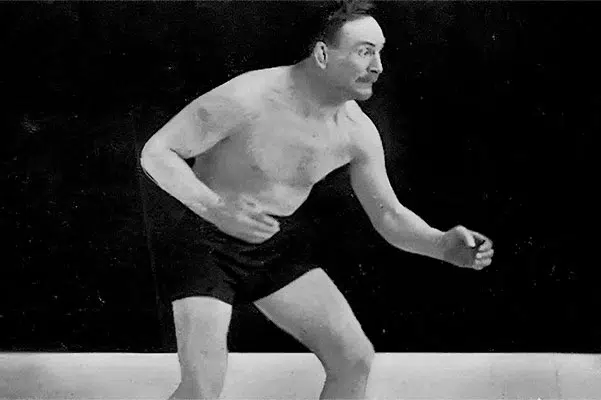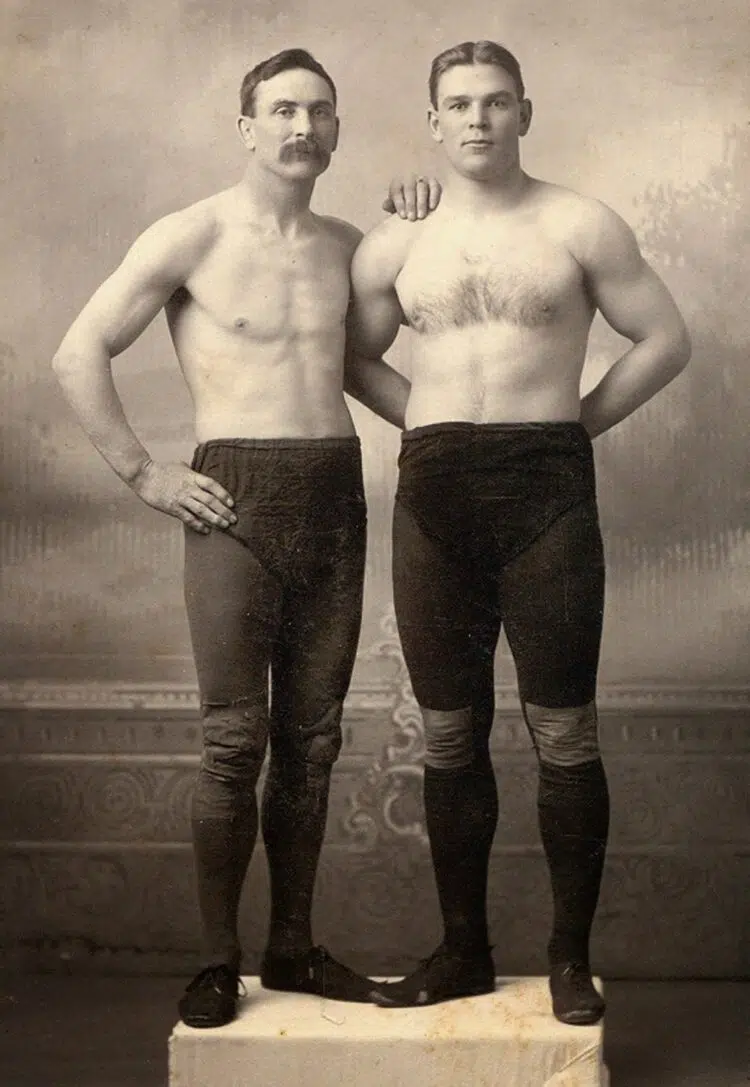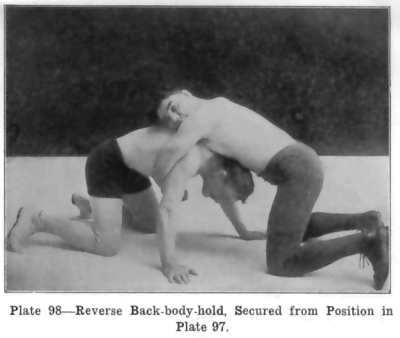Martin Burns (February 15, 1861 – January 8, 1937), popularly known as Farmer Burns, was an American catch wrestler, coach, and teacher. He started wrestling at an early age and won his first prize money of 15 cents at age eight by tossing an older rival.
Burns started working at a farm at the age of 11 to support his family — mother, brother, and five sisters. The intense physical labor helped Burns develop tremendous physical strength. Burns spent a considerable amount of time perfecting catch wrestling strategies and techniques.
Though Burns weighed just 165 pounds, he regularly outclassed opponents weighing 50 to 100 pounds more. Burns has been inducted into several Hall of Fames for his wrestling prowess, including the International Wrestling Institute and Museum Hall of Fame, the Wrestling Observer Newsletter Hall of Fame, The Professional Wrestling Hall of Fame, the WWE Hall Of Fame, and Nebraska Pro Wrestling Hall of Fame.
As I started my 60-plus hours of research about this legend, I was blown away by his journey, achievements, skills, and training techniques.
In this article, I take you over Farmer Burns’ grappling and strength training routine to help you build a strong and functional physique. I’ll also share how you can incorporate his methods into your existing training routine.
The Farmer Burns Workout Philosophy

Burns’ workouts weren’t designed by sports scientists trying to maximize the effectiveness of each rep; they were molded in the fires of competition, honed on the mats, and refined through years of relentless training.
Level Up Your Fitness: Join our 💪 strong community in Fitness Volt Newsletter. Get daily inspiration, expert-backed workouts, nutrition tips, the latest in strength sports, and the support you need to reach your goals. Subscribe for free!
The Farmer’s strength training routine blended seamlessly into his grappling training. Besides prioritizing strength, his workouts outside the gym focused on agility, flexibility, and the ability to control one’s opponent.
Core Principles of Farmer Burns’ Training
Burns’ training methods were rooted in the fundamentals of strength and grappling, ensuring that athletes of all experience levels could benefit from them. He also had some radical opinions about weight training.
“I believe the abnormal development brought about by the heavyweights is harmful.” — Farmer Burns
Although I don’t personally agree with this statement, one could understand Burns’ sentiment as weight training was often associated with becoming ‘muscle-bound’ back in that era.
Instead of prioritizing aesthetics, Burns focused on maximizing functional strength, which could translate to better performance in the wrestling ring.
Furthermore, Burns was a master grappler, and his workouts reflected this. He spent a considerable time honing his grappling skills, pinning techniques, sparring, and reflexes.
Wrestlers cannot afford to be slow. So, Burns dedicated a complete section to improving his speed, agility, flexibility, and endurance.
Core Components of Farmer Burns Workout

Many believe Burns’ greater contribution to wrestling was as a trainer. He opened a gym in Illinois and trained youngsters in catch wrestling. In 1899, Burns defeated a 21-year-old, Frank Gotch, but recognized his raw talent and recruited him as his student.
“The Grandmaster of American Wrestling” molded Gotch into notably one of the greatest wrestling champions of all time, as he defeated George Hackenschmidt, the creator of the bench press and hack squat, in 1908 to claim the undisputed World Heavyweight title.
Burns’ other notable students include future World Champion Earl Caddock, future Middleweight World Champion and Champion Wrestler of the A.E.F. Ralph Parcaut, as well as creative pioneer Joseph “Toots” Mondt.
The wrestling techniques with strength training you are about to read were released after Burns started coaching other wrestlers. Below is a breakdown of his methods:
Grappling Drills and Techniques
A wrestler must master several maneuvers to achieve a certain level of competitiveness. These are the basics of Burns’ routine:
- Takedowns: Single-leg, double-leg, and throws like the hip toss.
- Groundwork: Pins, escapes, and reversals.
- Submissions: Joint locks, chokes, and toe holds were Burns’ specialty.
Bodyweight Exercises and Calisthenics
Burns mainly relied on foundational bodyweight exercises to build strength. Here is a lowdown on the exercises he employed:
- Legs & Core: Squats and lunges
- Chest, Shoulders, & Triceps: Push-up variations
- Back & Biceps: Pull-ups and chin-ups
Strength Training with Implements
Burns didn’t have access to modern training equipment. He relied on dumbbells, barbells, and kettlebells for his training. These are some of the exercises he included in his training regime:
Outdoor Activities and Farm Work
Here’s some fun trivia for you — An event’s announcer introduced Burns to the crowd as “Farmer” Burns as he showed up at a competition dressed in his regular farmer’s overalls. It goes without saying that outdoor activities and farm work like chopping wood, carrying heavy loads, and working the fields made up a significant part of his routine.
Farmer Burns Workouts
Besides being a champion wrestler, Burns had an impeccable physique. Burns lost a wrestling match to Henry Clayton, as he couldn’t offset Clayton’s feared stranglehold. As a result, Burns dedicated himself to neck development and soon built a 20-inch neck.
Burns’ neck was so strong that he often performed a stunt at carnivals and fairs wherein he did a six-foot hangman’s drop and remained unharmed.
Burns’ workout differed significantly from the prevailing trends of his era. While his counterparts focused on building strength in isolation, Burns prioritized bodyweight exercises, calisthenics, and resistance training using unconventional tools like sandbags, barrels, and even live animals to keep him ahead of the pack.
Level Up Your Fitness: Join our 💪 strong community in Fitness Volt Newsletter. Get daily inspiration, expert-backed workouts, nutrition tips, the latest in strength sports, and the support you need to reach your goals. Subscribe for free!
In 1914, Burns published a 96-page mail-order course, ‘The Lessons in Wrestling and Physical Culture,’ which incorporated breathing techniques, calisthenics, stamina exercises, and Eastern martial arts principles, thus becoming the bible for all aspiring wrestlers during the early 1900s.
Burns developed the Farmer Burns workout for himself and his students. It mainly comprises bodyweight exercises, dumbbells, and aerobic exercises, such as running.
“The great secret of becoming a superior athlete lies in the attention to the little things.” — Farmer Burns
Three Phases of Farmer Burns Workout
Burn’s success in the wrestling ring is often credited to this tiered training regime. This iconic training program comprises three phases:
- First: Involves a combination of bodyweight stretches to prime the muscles for the workout.
- Second: Dumbbell high-intensity exercises to develop explosiveness and agility.
- Third: Bodyweight partner exercises to build strength, stamina, and coordination.
Burns’ training routine comprised deep breathing, stretching, isometric and isotonic exercises, dumbbell training, bodyweight calisthenics, self-defense, as well as practicing catch wrestling holds.
“The best of all exercises are those that furnish amusement and competitive interest.” — Farmer Burns
Sample Farmer Burns Workout Regime
Below is a Burns-inspired training routine that you can adopt to improve your strength, agility, and explosiveness:
| Day | Focus | Exercises |
| Monday | Grappling & Strength | Takedown drills, dumbbell presses, barbell rows |
| Tuesday | Grappling, Bodyweight & Calisthenics | Push-ups, pull-ups, squats, lunges |
| Wednesday | Rest or Active Recovery | Light cardio, stretching, mobility work |
| Thursday | Grappling & Kettlebells | Groundwork drills, kettlebell swings, Turkish get-ups |
| Friday | Grappling, Strength & Farm Work | Deadlifts, dumbbell curls, outdoor chores (e.g., chopping wood) |
| Weekend | Rest or Active Recovery | Hiking, swimming, or other enjoyable activities |
Benefits of Each Component
Unlike most modern routines, Burns’ system is considerably versatile and takes a holistic approach to fitness and overall well-being. Here are the benefits of adding each component to your regimen:
- Grappling: Boosts agility, coordination, functional strength, and self-defense skills.
- Bodyweight Exercises: Functional strength, improves body control, and can be done anywhere.
- Strength Training: Builds muscle mass and overall strength and improves bone health.
- Outdoor Activities: Improve cardiovascular conditioning, work capacity, functional strength, and endurance.
Although the current training landscape might be dominated by complex workout programming and hi-tech machines, Burns’ workout regime is a refreshing reminder of the power of simplicity and the importance of functional fitness.
Adapting the Workout For Modern Training Routines
Although Burns’ era might be a distant memory, his training philosophy and principles remain relevant. They are still used by elite wrestling coaches to refine raw talent and carve the most effective wrestlers.
This is how you can implement this 20th-century training regimen into your own routine for optimal strength, endurance, and functional fitness gains.
Embrace Bodyweight Exercises
Contrary to what most modern lifters think, bodyweight exercises aren’t just for beginners. Incorporate the bodyweight exercises listed in this article into your existing routine.
Feel free to modify the exercise or training volume based on your experience level and training objectives. Advanced lifters can perform them at the start of a workout to prime their muscles or as supersets to max out their muscle pumps. (1)
Use Resistance Bands & Indian Clubs
Most commercial gyms offer dumbbells. However, you might have to invest in a high-quality resistance band to optimize your training. Burns also used Indian clubs in his training to train his full body. Besides improving strength and muscle gains, this versatile tool can also improve core strength and stability.
Compound Movements
Isolation exercises aren’t the best use of a wrestler’s time. Compound movements involve multiple joints and muscles, which help build functional strength and can improve performance in daily tasks.
Progressive Overload
You must employ gradual progression to ensure your muscles have enough time to adapt to your routine. Start with lower-volume workouts and increase them linearly as your strength and fitness improve.
Also, on a highly demanding training regimen like this, training form triumphs over everything. Don’t bite off more than you can chew. Focus on training with the right form and increase the training intensity or load as you gain more experience.
Like any other fitness regime, the Farmer Burns grappling and streaming training system demands dedication, discipline, and consistency to yield the best results. Beginners should seek a professional’s guidance to design a personalized training regime according to their current fitness level and goals. It also shortens the initial learning curve, setting them up for success.
You must learn to listen to your body to maximize your results and limit the possibility of injuries. Stop an exercise immediately if you feel a sharp pain or discomfort. Consult your healthcare provider if the pain doesn’t subside within a few days.
Conclusion
In the annals of professional wrestling, a few names shine as bright as Burns’. ‘The Farmer’ was much more than a wrestler; he was a thinker and an accomplished coach who spread his teaching through his courses and gym.
If you want to improve your overall strength and functionality, I highly recommend you give Burns’ workout a try. Burns’ bodyweight-focused workouts will boost your overall strength, explosiveness, and agility.
If you have any doubts about the Farmer Burns workout regime, drop them in the comments below, and I’ll be happy to help!
References:
- Hirono, T., Ikezoe, T., Taniguchi, M., Tanaka, H., Saeki, J., Yagi, M., Umehara, J., & Ichihashi, N. (2022). Relationship Between Muscle Swelling and Hypertrophy Induced by Resistance Training. Journal of strength and conditioning research, 36(2), 359–364. https://doi.org/10.1519/JSC.0000000000003478









